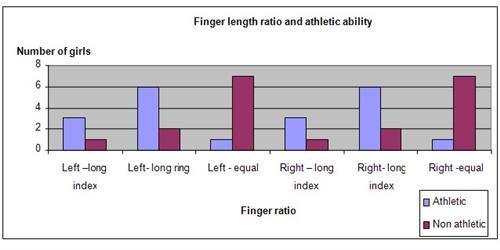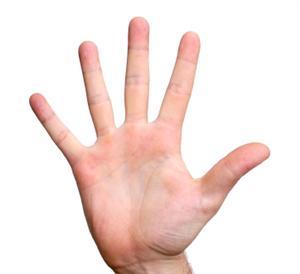| Complexity level: | 4 |
| Time required: | 1 hour to for preparation, 1 day for observation |
| Material availability: | Very easily found |
| Safety concerns: | None |
Hypothesis
Most of the athletic girls will have ring fingers that are longer than their index fingers.
Overview
Finger length and athletic capabilities
It has long been observed that men tend to have a longer ring finger than index fingers, while women’s index fingersand ring fingers are usually of equal length. A larger ring-to-index finger ratio in men has been associated with more aggressive behavior and better athletic abilities. As for women, their ring-to-index finger ratios are instead associated with verbal skills.
Researchers from King’s College, London have studied this phenomenon and it has been discovered that women who have a longer ring fingers than index fingers, tend to be very successful in athletics and other sports. They were found to be especially good in running events as well as other sports that involved running, such as football, hockey and tennis.
The difference in finger length was initially believed to be determined by the levels of testosterone in the womb. However, later studies have shown that finger length is mostly determined by genetic inheritance, and not by hormone levels. in the womb
Scientific Terms
Materials
The materials required for this science fair project:
- 10 athletic girls, age 15 years (athletes, tennis players, hockey players, etc.)
- 10 non-athletic girls, age 15 years
- A ruler
Procedure
1. For this science fair project, the independent variable is the athletic ability of the female participants. The dependent variable is the difference in the length of their index and ring fingers. This is determined by measuring the length of their fingers. The constants (control variables) are the age of the participants and the number of participants in each group.
2. Select ten girls aged 15 years old randomly from the school sports teams (e.g. hockey, track and field, tennis).
3. Compare the length of their index fingers and ring fingers on both their right and left hands, using the ruler. Note the number of girls who have longer ring or index fingers, and record your observations in a table, as shown below.
4. Select another 10 girls aged 15 years old from non-sports clubs and societies. Interview and select only girls who consider themselves non-athletic.
5. Measure and compare the length of the index and ring fingers of the girls. Note the number of girls who have longer ring or index fingers, and record your observations in a table, as shown below..

Results
It was observed that most of the athletic girls had longer ring fingers. When the index and ring fingers of the non-athletic girls were measured, it was observed that most of them had ring and index fingers of the same length. It was also found that the finger length ratio of both hands of almost all 20 girls was the same.
| Condition | Comparing index and ring finger lengths among athletic and non-athletic girls | |||||
| Left –longer index | Left- longer ring | Left – equal | Right – longer index | Right- longer ring | Right -equal | |
| Athletic | 3 | 6 | 1 | 3 | 5 | 2 |
| Non-athletic | 1 | 3 | 6 | 1 | 2 | 7 |
The above results were then plotted onto a graph, as shown below.

Conclusion
The hypothesis that most of the athletic girls will have a longer ring finger than index finger has been proven to be true.
The finger length ratio can be used to help identify potential athletes for training and grooming while they are still young. It has always been known that sports and athletic abilities are genetically inherited and the same genes might hold the answer to the finge- length ratio.
Also consider
What would happen if the science fair project was done to compare the finger length ratio of athletes in different areas of sports?
The experiment may be repeated to compare the finger length ratio in male athletes.
Also, what about toe length? If the finger-length ratio gives us clues about a person's athletic abilities, perhaps their toes may also do so?
References
Finger forecasts - http://www.washingtonpost.com/wp-dyn/content/article/2006/10/16/AR2006101600941.html
Finger length gives sports clues - http://news.bbc.co.uk/2/hi/health/5382814.stm

